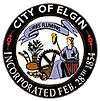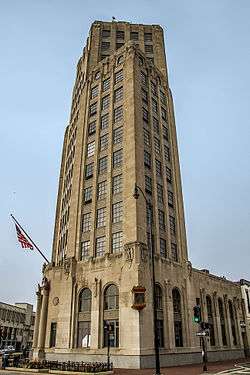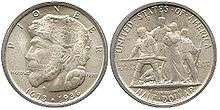Elgin, Illinois
| Elgin, Illinois | |||
|---|---|---|---|
| City | |||
|
Elgin Historical Museum | |||
| |||
| Nickname(s): Watch City | |||
| Motto(s): The Jewel of the Midwest | |||
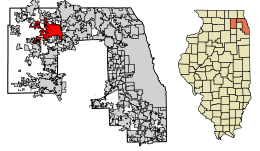 Location of Elgin in Cook County, Illinois. | |||
| Coordinates: 42°02′18″N 88°19′22″W / 42.03833°N 88.32278°WCoordinates: 42°02′18″N 88°19′22″W / 42.03833°N 88.32278°W[1] | |||
| Country |
| ||
| State |
| ||
| Counties | Kane, Cook | ||
| Townships | Elgin, Dundee, Rutland, Plato, Hanover Township, Cook County, Illinois | ||
| Incorporated | 1854 | ||
| Founded by | 1835 | ||
| Government | |||
| • Type | Home Rule, Council-manager | ||
| • Mayor | Dave Kaptain | ||
| • City Manager | Rick Kozal | ||
| Area[2] | |||
| • Total | 37.94 sq mi (98.25 km2) | ||
| • Land | 37.45 sq mi (96.98 km2) | ||
| • Water | 0.49 sq mi (1.27 km2) 1.43% | ||
| Elevation[1] | 817 ft (249 m) | ||
| Population (2010)[3] | |||
| • Total | 108,188 | ||
| • Estimate (2016)[4] | 112,123 | ||
| • Density | 2,994.34/sq mi (1,156.13/km2) | ||
| Standard of living (2011) | |||
| • Median household income | $56,091 | ||
| • Median home value | $209,800 | ||
| Time zone | UTC−6 (Central) | ||
| • Summer (DST) | UTC−5 (Central) | ||
| ZIP code(s) | 60120–60125 | ||
| Area code(s) | 847, 224, & 331 | ||
| Geocode | 17-23074 | ||
| FIPS code | 17-23074 | ||
| Demonym | Elginite | ||
| Website |
cityofelgin | ||
Elgin (/ˈɛldʒɪn/ EL-jin) is a city in Cook and Kane counties in the northern part of the U.S. state of Illinois. Located roughly 35 mi (56 km) northwest of Chicago, it lies along the Fox River. As of 2013, the city had a total population of 110,145,[5] making it the eighth-largest city in Illinois.
History
The Indian Removal Act of 1830 and the Black Hawk Indian War of 1832 led to the expulsion of the Native Americans who had settlements and burial mounds in the area, and set the stage for the founding of Elgin. Thousands of militiamen and soldiers of Gen. Winfield Scott's army marched through the Fox River valley during the war, and accounts of the area's fertile soils and flowing springs soon filtered east.
In New York, James T. Gifford and his brother Hezekiah Gifford heard tales of this area ripe for settlement, and travelled west. Looking for a site on the stagecoach route from Chicago to Galena, Illinois, they eventually settled on a spot where the Fox River could be bridged. In April 1835, they established the city, naming[6] it after the Scottish tune "Elgin".[7]
Early Elgin achieved fame for the butter and dairy goods it sold to the city of Chicago. Gail Borden established a condensed milk factory here in 1866, and the local library was named in his honor. The dairy industry became less important with the arrival of the Elgin Watch Company. The watch factory employed three generations of Elginites from the late 19th to the mid 20th century, when it was the largest producer of fine watches in the United States (the factory ceased production in 1965 and was torn down in the summer of 1966) and the operator of the largest watchmaking complex in the world.[8] Today, the clocks at Chicago's Union Station still bear the Elgin name.[9]
Elgin has a long tradition of education and invention. Elgin is home to the Elgin Academy, the oldest coeducational, non-sectarian college preparatory school west of the Allegheny Mountains. Elgin High School boasts five Navy admirals, a Nobel Prize winner, a Pulitzer Prize winner, a Tony Award winner, two Academy Award–winning producers, Olympic athletes and a General Motors CEO among its alumni. Elgin resident John Murphy invented the motorized streetsweeper in 1914 and later formed the Elgin Sweeper Corporation. Pioneering African-American chemist Lloyd Hall was an Elgin native, as was the legendary marketer and car stereo pioneer Earl "Madman" Muntz and Max Adler, founder of the Adler Planetarium in Chicago, America's first planetarium.[9]
Local historian E. C. Alft has written several books[10] and an ongoing newspaper column about Elgin's history.[11]
Geography
Topography
Elgin is located at 42°2′18″N 88°19′22″W / 42.03833°N 88.32278°W (42.0384225, −88.3226510).[1]
According to the 2010 census, Elgin has a total area of 37.704 square miles (97.65 km2), of which 37.16 square miles (96.24 km2) (or 98.56%) is land and 0.544 square miles (1.41 km2) (or 1.44%) is water.[12]
Climate
| Month | Jan | Feb | Mar | Apr | May | Jun | Jul | Aug | Sep | Oct | Nov | Dec | Year |
|---|---|---|---|---|---|---|---|---|---|---|---|---|---|
| Avg high °F | 29.6 |
34.0 |
45.5 |
58.7 |
69.7 |
79.8 |
83.6 |
81.9 |
75.1 |
62.0 |
47.5 |
33.2 |
58.4 |
| Avg low temperature °F | 13.7 |
17.0 |
26.8 |
37.4 |
47.7 |
57.8 |
63.0 |
61.2 |
52.3 |
40.1 |
30.4 |
17.8 |
38.8 |
| Rainfall in. | 1.65 |
1.50 |
1.97 |
3.67 |
4.35 |
3.88 |
3.81 |
4.97 |
3.42 |
2.92 |
3.09 |
2.02 |
37.24 |
| Snowfall in. | 9.9 |
7.6 |
2.9 |
0.4 |
0.0 |
0.0 |
0.0 |
0.0 |
0.0 |
0.0 |
0.7 |
8.3 |
29.7 |
| Source: NOAA[13] | |||||||||||||
On March 28, 1920, Elgin was struck by several tornadoes along the Fox River that caused significant damage to Chicago and several Western suburbs. Four people were killed and several businesses and homes were destroyed, including the Opera House and Grant Theater.[14]
Demographics
| Demographics (2010)[15] | |||
|---|---|---|---|
| White | Black | Asian | |
| 65.9% | 7.4% | 5.4% | |
| Islander | Native | Other | Hispanic (any race) |
| 0.0% | 1.4% | 16.3% | 43.6% |
| Historical population | |||
|---|---|---|---|
| Census | Pop. | %± | |
| 1860 | 2,797 | — | |
| 1870 | 5,441 | 94.5% | |
| 1880 | 8,787 | 61.5% | |
| 1890 | 17,823 | 102.8% | |
| 1900 | 22,433 | 25.9% | |
| 1910 | 25,976 | 15.8% | |
| 1920 | 27,454 | 5.7% | |
| 1930 | 35,929 | 30.9% | |
| 1940 | 38,333 | 6.7% | |
| 1950 | 44,223 | 15.4% | |
| 1960 | 49,447 | 11.8% | |
| 1970 | 55,691 | 12.6% | |
| 1980 | 63,798 | 14.6% | |
| 1990 | 77,010 | 20.7% | |
| 2000 | 94,487 | 22.7% | |
| 2010 | 108,188 | 14.5% | |
| Est. 2016 | 112,123 | [4] | 3.6% |
| U.S. Decennial Census[16] 2013 Estimate[17] http://elgindevelopment.com/edg/images/edg/uploads/files/Retail_Study_Final_1.pdf | |||
As of the census[18] of 2010, there were 108,188 people, and 37,848 households. The population density was 2,911.2 people per square mile. There were 37,848 housing units at an average density of 1,306.5 per square mile (504.5/km²). The racial makeup of the city was 65.9% White, 7.4% African American, 1.40% Native American, 5.4% Asian, 16.3% from other races, and 3.6% from two or more races. Hispanic or Latino of any race were 43.6% of the population. A significant portion of Elgin's Asian population was of Laotian origin.
There were 35,094 households out of which 38% had children under the age of 18 living with them, 52.6% were married couples living together, 13.3% had a female householder with no husband present, and 28.0% were non-families. 19.4% of all households were made up of individuals 65 years and older, and 7.1% had someone living alone who was 65 years of age or older. The average household size was 3.03 and the average family size was 3.56.
In the city, the population was spread out with 23.4% under the age of 18, 10.7% from 18 to 24, 33.6% from 25 to 44, 18.2% from 45 to 64, and 8.6% who were 65 years of age or older. The median age was 32.5 years. 50.2% of the population was female.
The median income for a household in the city was $56,337, and the median income for a family was $68,740. Males had a median income of $39,581 versus $28,488 for females. The per capita income for the city was $21,478. About 6.4% of families and 8.1% of the population were below the poverty line, including 11.6% of those under age 18 and 4.7% of those age 65 or over.
Elgin today
In 2013, Elgin ranked number one in the Chicago metropolitan area in new home starts, while ranking second in new home closings.[19] Elgin's downtown has also been the center of city renovations and new developments. New townhouses, condo towers, loft spaces, and art galleries have opened in the last decade. In October 2003 the Gail Borden Public Library moved into a new $30 million, 139,980 square foot, 460,000 volume-capacity building. In August 2009 the city opened the first ever satellite branch. The 10,000 square foot Rakow Branch, situated on Elgin's West Side, was LEED registered, and was designed to be expandable up to 30,000 square feet.[20] Elgin opened the 185,000 sq. ft. Centre of Elgin recreation facility across the street from the library. In 2009, Gail Borden was one of five libraries to receive the National Medal for Museum and Library Service issued by the Institute of Museum and Library Service in Washington DC.[21] In 2014, Elgin completed the Central Business District Streetscape Improvement Project and the Riverside Drive Promenade.
In the 1990s, Elgin became one of the few cities in northern Illinois to host a riverboat casino. The Grand Victoria Casino initially generated controversy, but went on to be a significant source of income for the city. Drawing nearly four million people annually, as of March 2005 it was the fifth most popular tourist attraction in Illinois. The Grand Victoria Foundation, to which the casino had contributed an amount in excess of $116 million, provides community grants to nonprofits in the city. In the years since, more casinos have opened in the area and the Grand Victoria Casino had seen attendance and revenue decline.
A significant Laotian American community calls Elgin home.[22] Elgin has been the sister city of Vientiane, the capital of Laos, since 1967. Some Laotian Americans have opened stores and restaurants, contributing to the city's cultural diversity.
Elgin's civic society is characterized by a large, diverse, and effective group of grassroots organizations, a sense of community pride and a spirit of volunteerism and participation. In recognition of this, for the second time, Elgin won the National Civic League's prestigious All-America City Award in 2002.
Government
Elgin was chartered as a city by the State of Illinois in 1854, and 100 years later became the first city in Illinois to adopt a council-manager form of government. Residents elect six at-large council members and a mayor, who serve on a part-time basis. The city council meets every other Wednesday at 6:00 pm at City Hall. The city manager, a full-time professional, serves at the pleasure of the mayor and city council.
Residents elect six at-large council members and a mayor, who serve on a part-time basis. The city manager, a full-time professional, serves at the direction of the mayor and city council. As a result of the 2010 census placing Elgin at 108,000 residents, two additional council seats was going to be elected in 2013, bringing the council to eight at-large members.
The current council members are Corey Dixon, Richard Dunne, Terry L. Gavin, Rosamaria Martinez, Tish S. Powell, Carol J. Rauschenberger, Toby Shaw, and F. John Steffen. Elgin's current mayor and city manager are Dave Kaptain and Rick Kozal, respectively.
The city council meets every second and fourth Wednesday at 6:00 pm in the council chambers, located on the second floor of city hall. Agenda and minutes are available online via www.cityofelgin.org. Residents may attend in person at city hall, watch the live video stream from the online newsroom, or view the replays on cable Channel 17.
The city is represented in the Illinois legislature by Representatives Anna Moeller (D), Steven Andersson (R), and Fred Crespo (D) and Senators Cristina Castro (D) and Karen McConnaughay (R). In the US House of Representatives, Elgin is represented by Randy Hultgren (R), Peter Roskam (R), and Raja Krishnamoorthi (D).
Elgin includes portions of Hanover Township in Cook County and Elgin Township, Plato Township, Rutland Township, Dundee Township, and Campton Township in Kane County. Elgin Township was governed by a supervisor (Annette Miller), highway commissioner (Rick Burnidge), clerk (Laura Wallett) and four trustees (Randy Endean, J. Patrick Hudgens, Robert Johnson, Vicki Pelock) elected to four-year terms.
Elgin Fire Department has 133 sworn firefighters, and 7 fire stations with plans to expand as the city grows. The front line fire apparatus consists of 6 ALS fire engines, 3 ladder trucks, 5 ALS ambulances, 2 boats, and a rescue raft, along with several vehicles used for inspections and other official business. Two of the ladder truck companies are part-time that double as part-time ambulances.
Arts, recreation and conservation
Elgin is home to the Elgin Symphony Orchestra. Other classical music groups include the Elgin Youth Symphony Orchestra, the Elgin Master Chorale, and the Elgin Children's Chorus. Outdoor music can be heard at the Wing Park Bandshell. Theatre groups include the Janus Theatre Company, Elgin Theatre Company, the Independent Players, Children's Theatre of Elgin, Fox Valley Youth Theatre, and Nothing Special Productions. Together, The Hemmens Cultural Center and Elgin Community College's Visual & Performing Arts Center host dozens of performances a year by performers ranging from Chicago's Hubbard Street Dance Company to comedian Bill Maher.
After losing many landmark businesses in the 1980s, downtown Elgin experienced a renaissance in the 1990s with the arrival of the Grand Victoria riverboat casino and improvement in the local economy. Many historic buildings have been transformed into stylish clubs and restaurants.
Elgin's city parks include 112-acre (45 ha) Lords Park, which features the Elgin Public Museum and a herd of American bison, and 121-acre (49 ha) Wing Park, which includes a golf course. Other golf courses within Elgin include the Highlands of Elgin, the Elgin Country Club, and Bowes Creek Country Club. The Centre of Elgin, which among other features includes an aquatic park and a climbing wall, remains one of the largest municipal recreation centers in the United States. The Elgin Sports Complex on the city's southwest side offers ten lighted ballfields, ten soccer fields and The Hill BMX track. The complex hosts several local, regional and national tournaments every year. Elgin connects to Algonquin and Dundee to the north, and St. Charles, Geneva, and Batavia to the south by the Fox River Trail bike path.
Although one of the largest and fastest-growing cities in Illinois, Elgin still retains some of the natural habitat diversity that first brought settlers to this area. On the east, the city borders the 4,200-acre (1,700 ha) Poplar Creek Preserve, maintained by the Cook County Forest Preserves, which includes bike trails, hiking trails and equestrian trails. The Shoe Factory Road Prairie located in the preserve provides an example of the hill prairies that once dotted the region. Poplar Creek Preserves connects to the 4,000-acre (1,600 ha) Spring Creek Valley Forest Preserve via a conservation easement covering parts of the Sears campus.
Elgin boasts two highly protected nature preserves, the Bluff Spring Fen and Trout Park. For its size, Bluff Spring Fen has a remarkable number of distinct plant communities, including a hill prairie and a fen, or alkaline spring marshland, which is home to several rare orchids. Trout Park also includes a similar calcareous seep community, with the addition of a unique forest community of oaks, ashes, maples, and uncommon species such as arborvitae and witch-hazel. When the park was created in the 1920s, the local newspaper ran a lengthy front-page story with lists of the plant species of Trout Park, reflecting both the great variety of plants present and the interest Elginites had in conservation. In the 1960s, the Northwest Tollway bisected the site and reduced it in size.
In recent years, Elgin has increased its efforts to be more environmentally sustainable. In 2017, the city introduced free curbside textile recycling to residents, and it is the first city in Illinois to do so.[23] Additionally, Elgin encourages its residents to compost and use rain barrels, which it sometimes subsidizes for residents to purchase.[24] The city also has a proposed Sustainability Action Plan that includes plans for creating renewable sources of energy for the city, a proposed curbside organics/composting pilot-program, and information about community gardens.[25]
Architecture and historic preservation
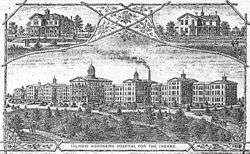
The city was known for its historic architecture and landmarks from the Victorian era, including some fine examples of homes in the Queen Anne style. Many of the most remarkable homes once belonged to National Watch Company executives. Many interesting Sears Catalog Homes arrived in Elgin as kits from 1908 to 1940. The Elgin Tower Building, erected in 1929, is a historic office building downtown.
Predating Victorian homes were homes made of native cobblestone. It was believed that Elgin had at one time the largest concentration of cobblestone homes outside of Rochester, New York. Several such homes built by the earliest settlers still stand. They can be seen in Elgin's historic districts, two of which are recognized by the National Register of Historic Places.
The Elgin Public Museum at Lords Park was the oldest building in Illinois built expressly as a museum that was still serving that purpose.
The nine-member Elgin Heritage Commission promotes historic preservation activity. The Gifford Park Association was also active in historic preservation, and conducts a popular annual house tour.
Transportation
Metra
Elgin has three stations on Metra's Milwaukee District/West Line, which provides daily rail service between Elgin and Chicago Union Station): National Street, Elgin, and Big Timber Road. Big Timber Road is the western terminus of this service, however it is not serviced by the Metra on weekends or major U.S. holidays as trains terminate at Elgin on those days.
Elgin used to have a streetcar system, operated by the Aurora, Elgin and Fox River Electric Company. Additionally, Elgin was served by several interurban lines. The most prominent of these was the Chicago Aurora and Elgin Railroad which provided frequent service into Chicago.
Local bus service is provided by PACE (the Suburban bus provider of the Northeastern Illinois Regional Transportation Authority). PACE operates about a dozen bus routes in the city with service running Monday through Saturday. Most of the routes terminate at the Elgin Transportation Center located at 100 West Chicago Street in downtown. Routes generally run every half hour and meet up at the terminal at the same time to provide convenient transferring. Several routes also travel out of Elgin to other nearby suburbs, such as Carpentersville, Dundee (Spring Hill Mall), Schaumburg (Woodfield Mall), and St. Charles (Charlestowne Mall and connecting bus service to Aurora and Geneva).
Pace operates an express route between Elgin and the Rosemont station on the Blue Line.[26] The service operates along I-90. Access to the bus route is via the Elgin Transportation Center, the Randall Road park and ride lot, and the IL-25 park and ride lot.[27]
Major highways
Major highways in Elgin include:
Education
Four public school districts and 18 private schools serve Elgin.
- Elgin Area School District U46—Elgin-based, serves most of Elgin
- U-46, the second largest school district in Illinois, serves an area of some 90 square miles (230 km2) in Cook, DuPage and Kane Counties. Almost 40,000 children of school age are in its area. Elgin's two public high schools, Elgin High School and Larkin High School, are home to the Gifted and Talented Academy and the Visual and Performing Arts Academy, respectively. U-46 also operates the Elgin Math & Science Academy, a charter school, which will open for the Fall 2018 school year, initially serving grades K-3.[28]
- Community Unit School District 301—Burlington-based, serves some western portions of Elgin
- Community Unit School District 300—Carpentersville-based, serves some northwestern portions of Elgin
- Community Unit School District 303—St. Charles-based, serves some southwestern portions of Elgin
Private schools include:
- Harvest Christian Academy
- Highland Christian Academy
- The Einstein Academy
- Elgin Academy
- Fox Valley Lutheran Academy
- Good Shepherd Lutheran School
- Northwest Baptist Academy
- St. Edward Central Catholic High School
- St. John's Lutheran School
- St. Joseph Catholic Elementary School
- St. Laurence Catholic Elementary School
- St. Mary Elementary School
- St. Thomas More Catholic Elementary School
- Westminster Christian School
Accredited colleges and universities
- Elgin Community College[29] serves the district #509 communities of St. Charles, Burlington, South Elgin, Wayne, Bartlett, Algonquin, Dundee, Hampshire and smaller towns, and was one of the fastest-growing community colleges in the state.
- Judson University, an accredited,[30] four-year liberal arts American Baptist college, sits on the banks of the Fox River on the city's northwest side. Judson features graduate programs in architecture and education.
- National Louis University, an accredited [31] private non-profit undergraduate and graduate institution of higher learning, in colleges of education, arts and sciences, and business and management.
Unaccredited college
- Providence Baptist College, is an unaccredited four-year Independent Baptist vocational college. Providence Baptist College was not accredited by any recognized higher education accreditation body. Therefore, its degrees may not be acceptable to employers or other institutions, and use of degree titles may be restricted or illegal in some jurisdiction.
Notable people
Commemorative coin
In 1936, a commemorative silver half dollar was issued by the United States Mint commemorating the centennial of Elgin. The coin was meant to raise money for the pioneer family memorial proposed by Elgin sculptor Trygve Rovelstad, and sold for $1.50. The obverse features the profile of a pioneer with the dates 1673 * 1936, while the reverse features a pioneer family; both images are based on a centennial "Pioneer Medal" made by Rovelstad.[32] The date 1673 was in reference to the expedition of Louis Jolliet and Jacques Marquette, despite the fact that their journey took them nowhere near the future site of Elgin.
The coin did not prove to be a popular success, probably because of the Great Depression and the great variety of commemorative coins being issued at the time. Five thousand of the 25,000 coins initially minted were unsold and melted down by the mint. Rovelstad's pioneer statue was not installed until 2001.
Elgin in mass media
- Elgin was one of the communities around the Chicago metropolitan area affected by the 1920 Palm Sunday tornado outbreak on March 18, 1920.
In film
- Scenes from the film Four Friends (1981) were shot in the west side neighborhood just above the Woodruff and Edwards foundry.
- Part of the comedy film Dennis the Menace (1993) was set in Elgin.
- The Elgin Mental Health Center appears in the movie Primal Fear (1996).
- A scene in the suspense/thriller film Contagion (2011) was filmed in Elgin's Sherman Hospital.
- Parts of the horror film Plastic were shot in Elgin.
- A scene in the 2010 film A Nightmare on Elm Street was shot in Elgin's Bluff City Cemetery.
- Purge Feed footage depicts Elgin in The Purge (2013).
In television
- The exterior of the home in the television series Grace Under Fire was on Elgin's east side at 445 DuPage Street.[33]
- In "Unearthed", an episode of the television series Prison Break, Dr. Sara Tancredi stayed at a motel in Elgin.[34]
- The television series Roseanne was set in the fictional town of Lanford but was modeled after Elgin.[35] At one point, Jackie attends a trucking school in Elgin. In the episode "Crime and Punishment", Roseanne offers to take Jackie to the hospital in Elgin.[36]
- Wyatt Cenac's Problem Areas featured the Elgin Police Department's community policing strategies in its episode "Energy Problems, Millennial Problems, Community Policing Problems" which aired on April 27, 2018.[37]
References
- 1 2 3 U.S. Geological Survey Geographic Names Information System: City of Elgin
- ↑ "2016 U.S. Gazetteer Files". United States Census Bureau. Retrieved Jun 29, 2017.
- ↑ "Elgin (city), Illinois". State & County QuickFacts. U.S. Census Bureau. 8 July 2014. Archived from the original on 29 July 2012. Retrieved 16 September 2014.
- 1 2 "Population and Housing Unit Estimates". Retrieved June 9, 2017.
- ↑ "Annual Estimates of the Resident Population for Incorporated Places of 50,000 or More, Ranked by July 1, 2013 Population: April 1, 2010 to July 1, 2013". U.S. Census Bureau, Population Division. May 2014. Retrieved 16 September 2014.
- ↑ Alft, E.C. (1984). Elgin: An American History. Crossroads Communications, Ashton, IL. ISBN 0-916445-09-7.
- ↑ The Congregational Hymn and Tune Book. General Association of Connecticut. 1856. p. 120.
- ↑ Aft, E.C. (2000). Elgin: An American History. ElginHistory.com. Retrieved September 16, 2013.
- 1 2 "Elgin: Days Gone By by E. C. Alft". Elginhistory.com. Retrieved 2015-03-16.
- ↑ "The History of Elgin, Illinois". ElginHistory.com. Retrieved 2015-03-16.
- ↑ "Suburbs - Chicago Tribune". Suburbanchicagonews.com. Retrieved 2015-03-16.
- ↑ "G001 - Geographic Identifiers - 2010 Census Summary File 1". United States Census Bureau. Retrieved 2015-12-27.
- ↑ "NowData - NOAA Online Weather Data". National Oceanic and Atmospheric Administration. Retrieved December 27, 2012.
- ↑ "Effects of a Tornado along the Fox River in Elgin, 1920". www.encyclopedia.chicagohistory.org. Retrieved 2017-10-16.
- ↑ "Profile of General Population and Housing Characteristics: 2010 Demographic Profile Data (DP-1): Elgin city, Illinois". U.S. Census Bureau, American Factfinder. Retrieved February 11, 2013.
- ↑ United States Census Bureau. "Census of Population and Housing". Archived from the original on May 12, 2015. Retrieved April 27, 2015.
- ↑ "Annual Estimates of the Resident Population: April 1, 2010 to July 1, 2013". Archived from the original on May 22, 2014. Retrieved April 27, 2015.
- ↑ "American FactFinder". United States Census Bureau. Archived from the original on 2013-09-11. Retrieved 2008-01-31.
- ↑ "Elgin Housing Market Shows Strength in 2013 Numbers". Crown-highlandwoods.com. Retrieved 2015-03-16.
- ↑ "Rakow Branch - Gail Borden Public Library District - Elgin, Illinois". Gailborden.info. 2009-08-15. Retrieved 2015-03-16.
- ↑ "History of the Library - Gail Borden Public Library District - Elgin, Illinois". www.gailborden.info. Retrieved 2017-10-16.
- ↑ "Laotians". Encyclopedia.chicagohistory.org. Retrieved 2015-03-16.
- ↑ "Elgin Is First Illinois City To Offer Simple Curbside Textile Recycling". Kane County Connects. 2017-07-07. Retrieved 2017-10-16.
- ↑ "Elgin". Elgin. Retrieved 2017-10-16.
- ↑ "City of Elgin, Illinois - Official Website - Sustainability Action Plan". www.cityofelgin.org. Retrieved 2017-10-16.
- ↑ Danahey, Mike. "New Pace bus routes between Elgin and suburban locations launched this week". Elgin Courier-News. Retrieved 2017-09-14.
- ↑ "Pace, Tollway deal would ramp up service along I-90". Daily Herald. Retrieved 2014-08-22.
- ↑ https://www.dailyherald.com/news/20171003/despite-funding-concerns-state-panel-oks-elgin-charter-school
- ↑ "Higher Learning Commission". Ncahlc.org. Retrieved 2015-03-16.
- ↑ "Higher Learning Commission". Ncahlc.org. Retrieved 2015-03-16.
- ↑ "Higher Learning Commission". Ncahlc.org. Retrieved 2015-03-16.
- ↑ "Elgin Commemorative Half Dollar". Coinfacts.com. 2001-11-11. Retrieved 2015-03-16.
- ↑ "Google Maps". Google.com. 1970-01-01. Retrieved 2015-03-16.
- ↑ "Prison Break Unearthed Plot Summary". IMDB. Retrieved 2014-08-22.
- ↑ "Scene Stealers". Chicago Tribune. Retrieved 2014-08-22.
- ↑ "Crime and Punishment". TV.com. Retrieved 2014-08-22.
- ↑ "HBO's Wyatt Cenac's 'Problem Areas' to spotlight policing in Elgin on Friday's episode". Chicago Tribune. 2018-04-07. Retrieved 2018-08-07.
External links
| Wikimedia Commons has media related to Elgin, Illinois. |

